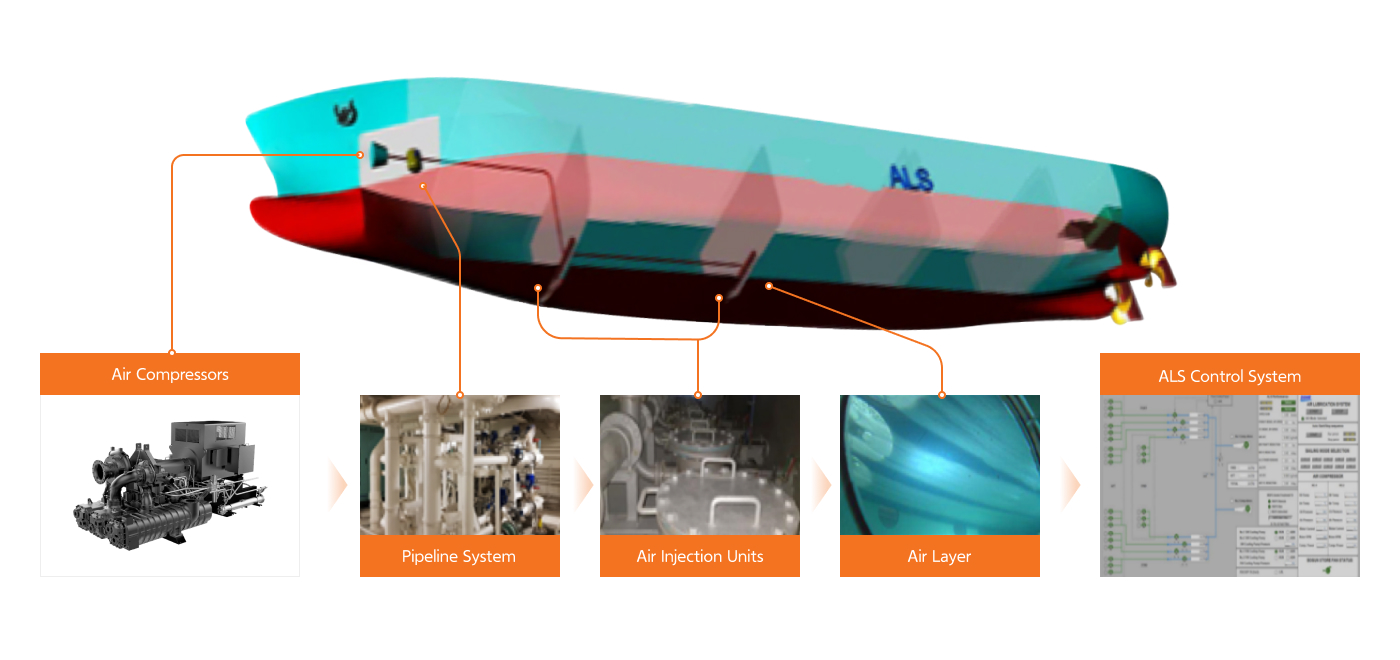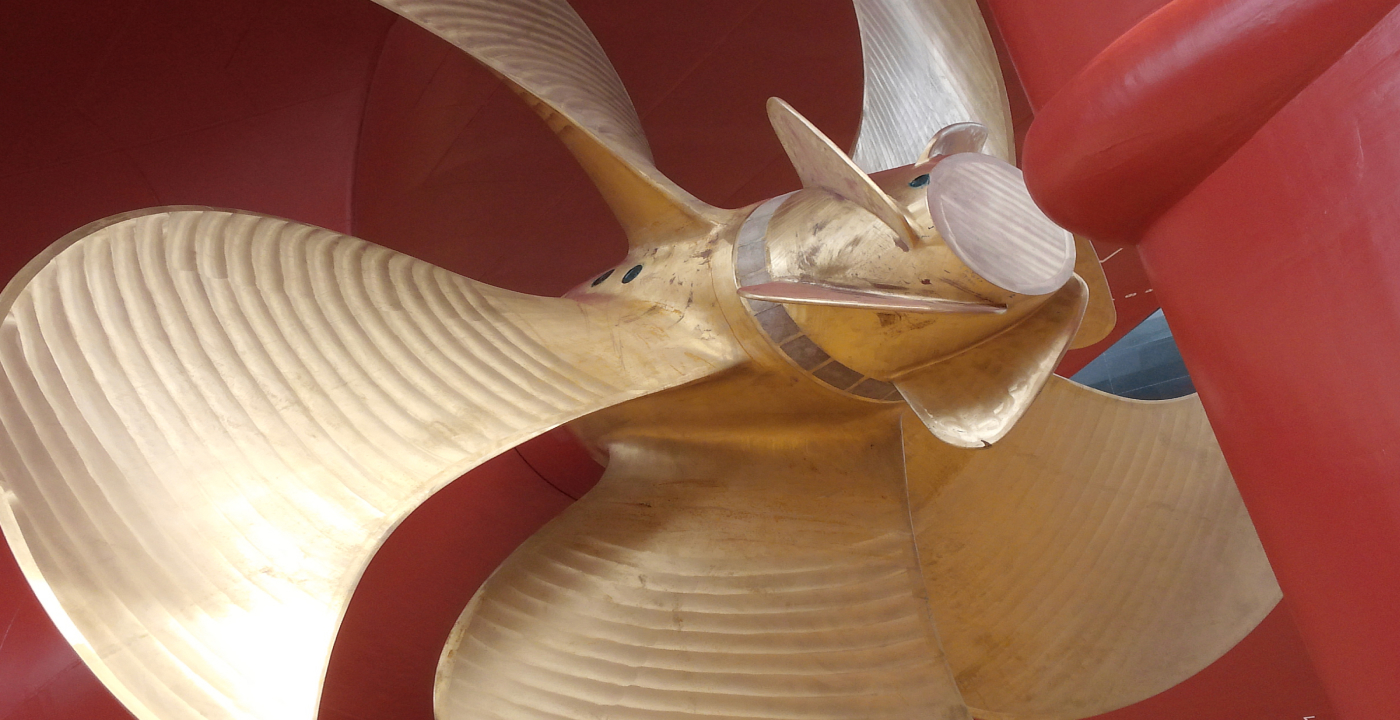De-carbonization Retrofit Solutions
BOG Re-liquefaction System(NRS/Sub-cooling)
Reliquefaction systems can manage Boil-off Gas(BOG) from existing LNG carriers more efficiently and economically while significantly supporting environmental compliance.
Our proprietary NRS(Nitrogen Refrigerant System) reliquefies BOG using cooling efficiency generated through N₂ compression and expansion via the N₂ Reverse Brayton Cycle.
Our proprietary NRS(Nitrogen Refrigerant System) reliquefies BOG using cooling efficiency generated through N₂ compression and expansion via the N₂ Reverse Brayton Cycle.
Scope of Work
-
Re-liquefaction System
(Hanwha NRS / Sub-cooler) -
Cooling Sea / Fresh Water Pump /
Cooler in Engine Room -
Electrical Modification
Reliquefaction capacity : Hanwha NRS(2.1/2.8 TPH), Sub-cooler(1.5/2.1 TPH)
ALS(Air Lubrication System)
ALS increases vessel operating efficiency by reducing friction resistance between the ship and water.
Our air compressor system forms an air layer under the vessel to minimize power consumption and improve fuel efficiency.
Our air compressor system forms an air layer under the vessel to minimize power consumption and improve fuel efficiency.
Scope of Work
-
One(1) Air Compressor
(Turbo Type, less OPEX than Screw Type) -
Air Injection Units with Including
Pipelines, Flow Control Valves -
FW, LO Coolers for Air and
Compressor -
Control & Monitoring System
Benefit : Net Power Saving of Approx. 5~9%

Rotor Sail System
The Rotor Sail System generates propulsion using the Magnus effect* by creating pressure differences between the front and rear of the rotor.
This eco-friendly technology reduces greenhouse gas emissions, satisfying GHG regulations. By establishing the world's first Rotor Sail System demonstration center, we are staying ahead in environmental protection and energy efficiency.
* Magnus effect: A phenomenon where a rotating object moving through a fluid(liquid or gas) experiences a force perpendicular to its direction of motion and rotation.
This eco-friendly technology reduces greenhouse gas emissions, satisfying GHG regulations. By establishing the world's first Rotor Sail System demonstration center, we are staying ahead in environmental protection and energy efficiency.
* Magnus effect: A phenomenon where a rotating object moving through a fluid(liquid or gas) experiences a force perpendicular to its direction of motion and rotation.
Scope of Work
-
Number of Rotor Sales with Foundation
-
Wind Sensor
-
Electrical & Control System
Benefit : Increase abt. 3 - 4% Fuel Efficiency per Rotor
CFD Analysis & Wind Tunnel Test
-
LNGC 2-Rotor Sail

-
VLCC 3-Rotor Sail

Energy Saving Devices
We provide various energy-saving device solutions for fuel reduction, regulatory compliance, and efficiency improvement.
Our solutions help vessels stay ahead in profitability and competition.
Our solutions help vessels stay ahead in profitability and competition.
Bulbous Bow Optimization
Bulbous Bow Optimization increases vessel efficiency and protects the environment.
Optimized Bulbous Bows enable more efficient operation and drive sustainable development in the shipping industry.
Optimized Bulbous Bows enable more efficient operation and drive sustainable development in the shipping industry.
Bulbous Bow Retrofit
-
Hull Resistance Reduction
-
Propulsion Efficiency Increase
-
Expected Efficiency : 4~5%
Propeller Optimization
Propeller Optimization analyzes propeller shape, size, and material to improve fuel efficiency, reduce noise and vibration, enhance propulsion efficiency, increase vessel speed and maneuverability, and extend service life.
Propeller Optimization
-
Propulsion Efficiency
-
Ship Vibration and Noise Reduction
-
Expected Efficiency : 3~5%
Propeller Boss Cap Fin Retrofit
Propeller Boss Cap Fin modification involves installing or replacing propeller boss cap fins on existing vessels, reducing vortices(swirls behind the propeller) to improve fuel efficiency, reduce exhaust emissions, contribute to environmental protection, and innovatively enhance vessel speed and maneuverability.
Propeller Cap-Fin Installation
-
Propulsion Efficiency
-
Reduced Tip Vortex Cavitation
-
Expected Efficiency : 1~1.5%
